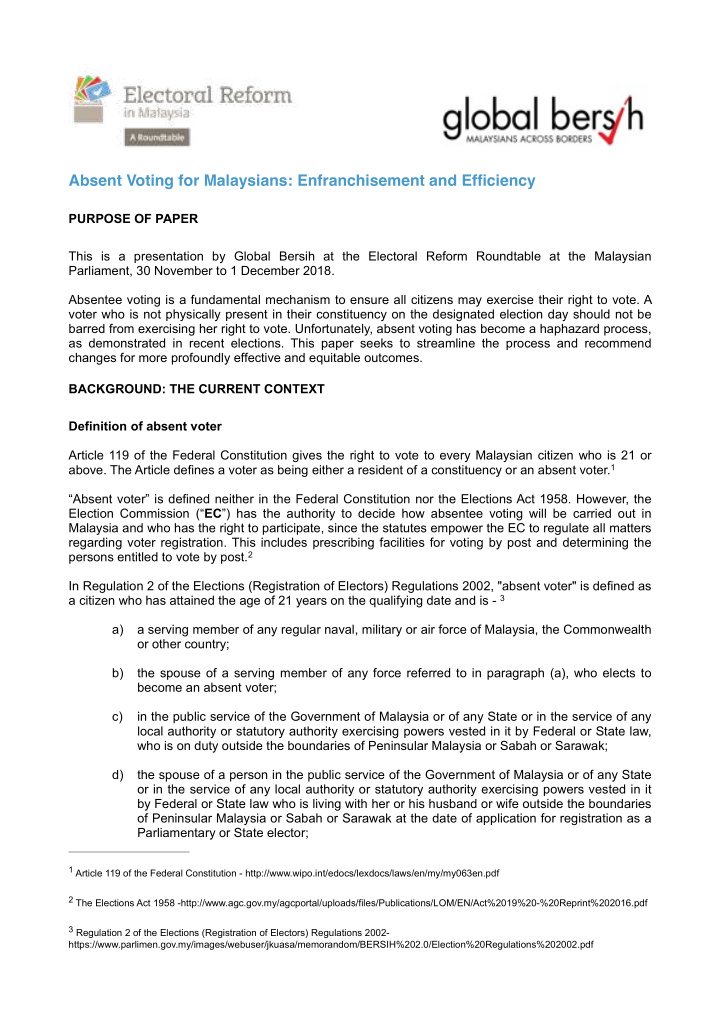



� � Absent Voting for Malaysians: Enfranchisement and Efficiency PURPOSE OF PAPER This is a presentation by Global Bersih at the Electoral Reform Roundtable at the Malaysian Parliament, 30 November to 1 December 2018. Absentee voting is a fundamental mechanism to ensure all citizens may exercise their right to vote. A voter who is not physically present in their constituency on the designated election day should not be barred from exercising her right to vote. Unfortunately, absent voting has become a haphazard process, as demonstrated in recent elections. This paper seeks to streamline the process and recommend changes for more profoundly effective and equitable outcomes. BACKGROUND: THE CURRENT CONTEXT Definition of absent voter Article 119 of the Federal Constitution gives the right to vote to every Malaysian citizen who is 21 or above. The Article defines a voter as being either a resident of a constituency or an absent voter. 1 “Absent voter” is defined neither in the Federal Constitution nor the Elections Act 1958. However, the Election Commission (“ EC ”) has the authority to decide how absentee voting will be carried out in Malaysia and who has the right to participate, since the statutes empower the EC to regulate all matters regarding voter registration. This includes prescribing facilities for voting by post and determining the persons entitled to vote by post. 2 In Regulation 2 of the Elections (Registration of Electors) Regulations 2002, "absent voter" is defined as a citizen who has attained the age of 21 years on the qualifying date and is - 3 a) a serving member of any regular naval, military or air force of Malaysia, the Commonwealth or other country; b) the spouse of a serving member of any force referred to in paragraph (a), who elects to become an absent voter; c) in the public service of the Government of Malaysia or of any State or in the service of any local authority or statutory authority exercising powers vested in it by Federal or State law, who is on duty outside the boundaries of Peninsular Malaysia or Sabah or Sarawak; d) the spouse of a person in the public service of the Government of Malaysia or of any State or in the service of any local authority or statutory authority exercising powers vested in it by Federal or State law who is living with her or his husband or wife outside the boundaries of Peninsular Malaysia or Sabah or Sarawak at the date of application for registration as a Parliamentary or State elector; 1 Article 119 of the Federal Constitution - http://www.wipo.int/edocs/lexdocs/laws/en/my/my063en.pdf 2 The Elections Act 1958 -http://www.agc.gov.my/agcportal/uploads/files/Publications/LOM/EN/Act%2019%20-%20Reprint%202016.pdf 3 Regulation 2 of the Elections (Registration of Electors) Regulations 2002- https://www.parlimen.gov.my/images/webuser/jkuasa/memorandom/BERSIH%202.0/Election%20Regulations%202002.pdf
e) engaged in full-time studies at any university, training college or any higher education institution outside the boundaries of Peninsular Malaysia or Sabah or Sarawak; or f) the spouse of a person engaged in full-time studies at any university, training college or any higher education institution outside the boundaries of Peninsular Malaysia or Sabah or Sarawak who is living with her or his husband or wife at the date of application for registration as a Parliamentary or State elector. Two voting methods for absent voters: advance voting and postal voting Two methods currently in use for absentee voting in Malaysian elections: a) Advance voting – for voters from category (a) who will be on official duty on the election day and (b). b) Postal voting – for voters from categories (c) to (f). In the 13th General Election (" GE13 ") the “postal vote” was, for the first time, offered to Malaysian citizens overseas who previously did not fit the description of an "absent voter" as defined in Regulation 2 of the Elections (Registration of Electors) Regulations 2002. To be specific, the methodology that was used fits better under the term “overseas advance voting” as the method of voting was that voters still had to submit ballots in person at the overseas polling locations. During the 14th General Election (" GE14 ") for the first time, postal voting in the real sense was opened to Malaysian citizens overseas who previously did not fit the description of an "absent voter" as defined in Regulation 2 of the Elections (Registration of Electors) Regulations 2002. Overseas Malaysians could register to vote online, and the ballot papers were sent by post and were to be returned by post within the set deadline. Note, however, that this option was not open to Malaysians in neighbouring countries – see below. Although postal voting is one of the most feasible options for overseas voters, the overseas postal voting system in GE14 was a glaring failure because of systemic inefficiencies and impossible time constraints (see Appendix 2) . We therefore propose to modify the existing postal voting framework by streamlining the absent voting process and extending the campaign period to accommodate postal logistics. OVERSEAS MALAYSIANS: A GROWING ELECTORATE The current interpretation of absent voters is outdated as it was developed at a time when fewer Malaysians were residing abroad. In a report called “Malaysian Economic Monitor: Brain Drain”, the World Bank shows that in 1980 the Malaysian diaspora was estimated at 286,102 worldwide, growing into an estimation of 452,109 in 1990. According to recent United Nations estimates, the number of 4 Malaysians abroad soared to 1.9 million in 2017 from 1 million in 2010. 5 6 In Singapore alone, the World Bank placed the number of Malaysian diaspora at close to 385,979 in 2010. The numbers show a more than 20% rise compared with ten years earlier in 2000 when the figure recorded by World Bank was 303,828. If we project the existing World Bank statistics, the 4 See http://documents.worldbank.org/curated/en/282391468050059744/pdf/614830WP0malay10Box358348B01PUBLIC1.pdf - Page 90 5 See http://www.migrationdataportal.org/data?cm49=458&focus=profile&i=stock_abs_&t=2017 6 See http://documents.worldbank.org/curated/en/282391468050059744/pdf/614830WP0malay10Box358348B01PUBLIC1.pdf - Page 12
Recommend
More recommend